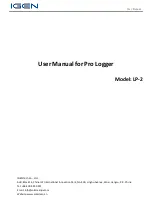
OMC-042 / 043 / 044 Data loggers
Users
’ manual
page 77
Alarming
In some circumstances, normal data-logging is not sufficient for managing your process. For keeping track
of certain, often critical, conditions, the data logger is equipped with direct alarming options. Alarming-limits
and hysteresis are used to manage these special events. The table below shows the different types of
alarming-limits.
Alarm
Limit
Description
Remarks
Low-Low
Alarm level for lowest value
This alarm level is reached when the data logger
encounters a value which is lower than the low-low Limit,
this is the 2nd and most urgent state of alarming. This
type of alarming is used for very rare and critical
conditions. (often called STOP level)
Low
Alarm level for low value
This alarm level is reached when the data logger
encounters a value which is Lower than the Low Limit,
but Higher than the Low-Low Limit. This is the first stage
of alarming. (often called WARNING level)
High
Alarm level for high value
This alarm level is reached when the data logger
encounters a value which is higher than the high Limit,
but lower than the High-High Limit. This is the first stage
of alarming. (often called WARNING level)
High-High
Alarm level for highest value
This alarm level is reached when the data logger
encounters a value which is higher than the high-high
Limit, this is the 2nd and most urgent state of alarming.
This type of alarming is used for very rare and critical
conditions (often called STOP level).
Alarming - principal of operation
When a data logger is running and a measurement is out of boundary, the data logger will immediately
switch over the alarm sample interval. So the first time a
–out of boundary-value will be detected is at the
normal data-log interval and from this moment on,
the data logger will increase its sample interval to the
alarm-
sample interval. The “alarm sample delay” determines what happens next. If this value is equal to
zero, action is taken immediately. If the sample interval delay is 1, the logger will wait for one more alarming
cycle upon taking action. If the alarm interval delay is 2, it will take 2 cycles, etc.
When this alarm-
state is entered, the data logger will add the ‘*A’ data modifier to the data-records. The
user has the following options for the requested action:
1) Alarm log (log an alarm level)
2) Alarm SMS (send an SMS to cell phone)
3) Direct log data output on alarm (HTTP, E-mail, FTP or TCP)
So, when the conditions of alarming are met (data value out of bounds and the alarm sample delay is
expired) one or more of these actions can take place.
Note:
The alarm log is a log of synoptically data into an S-record. The data modifier *A is automatically
placed into the D-records.
















































